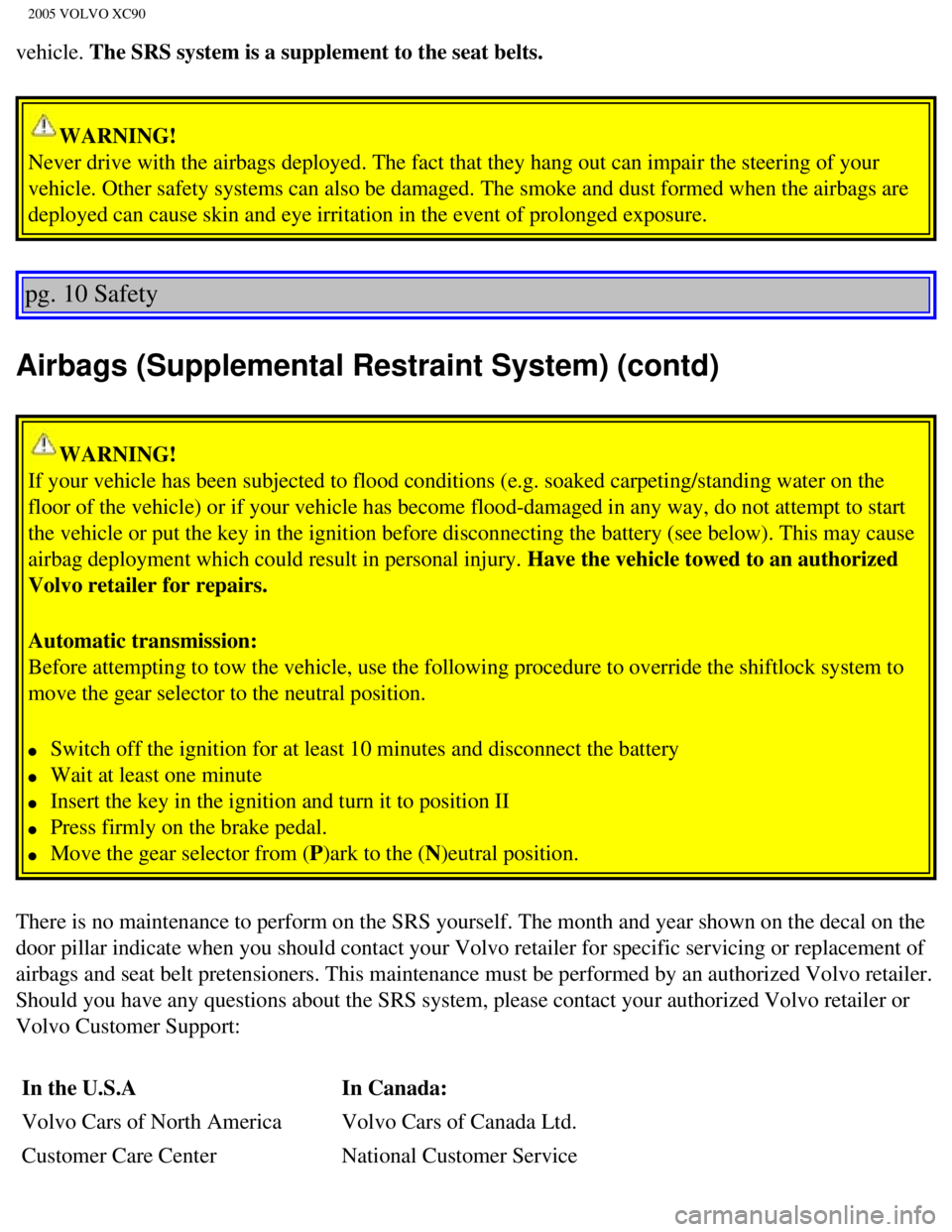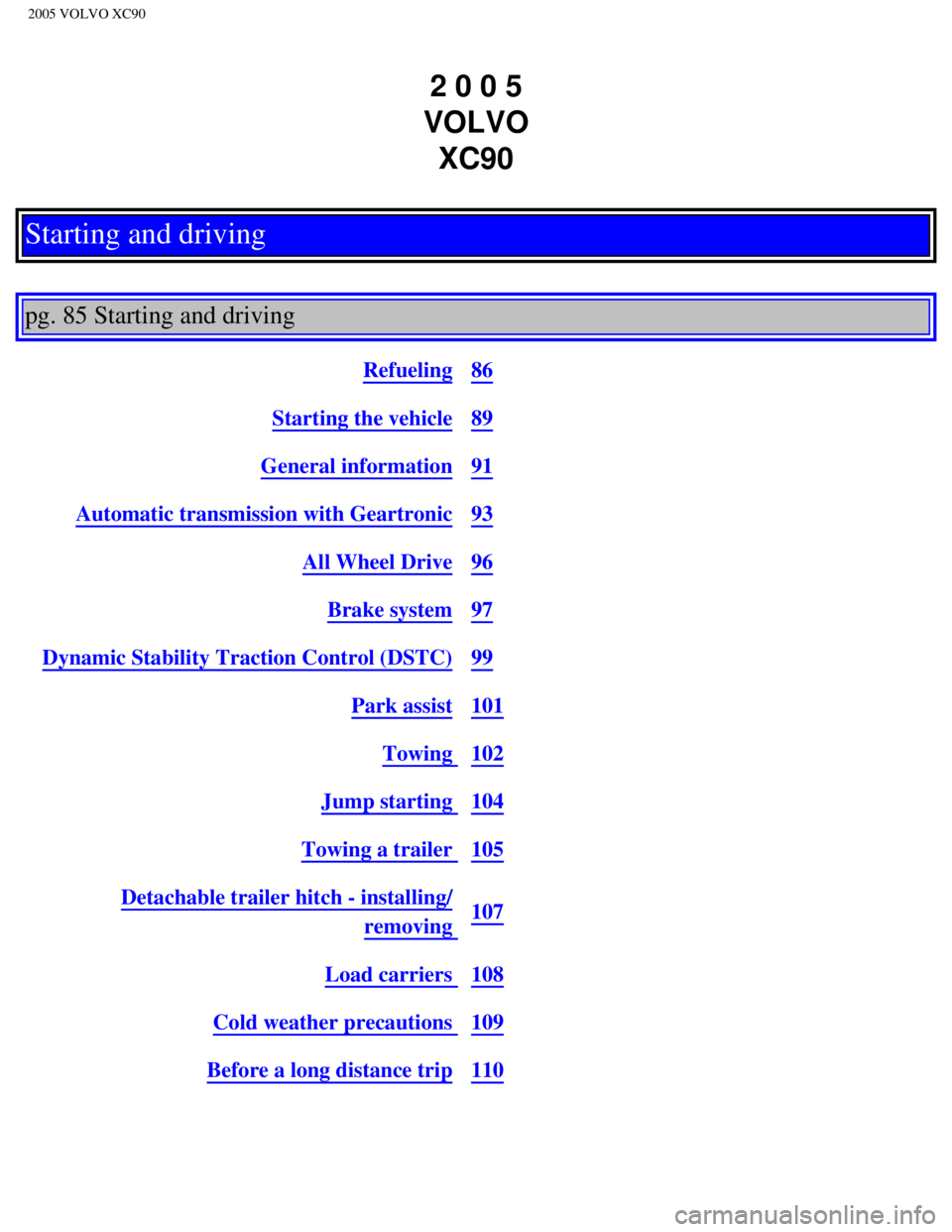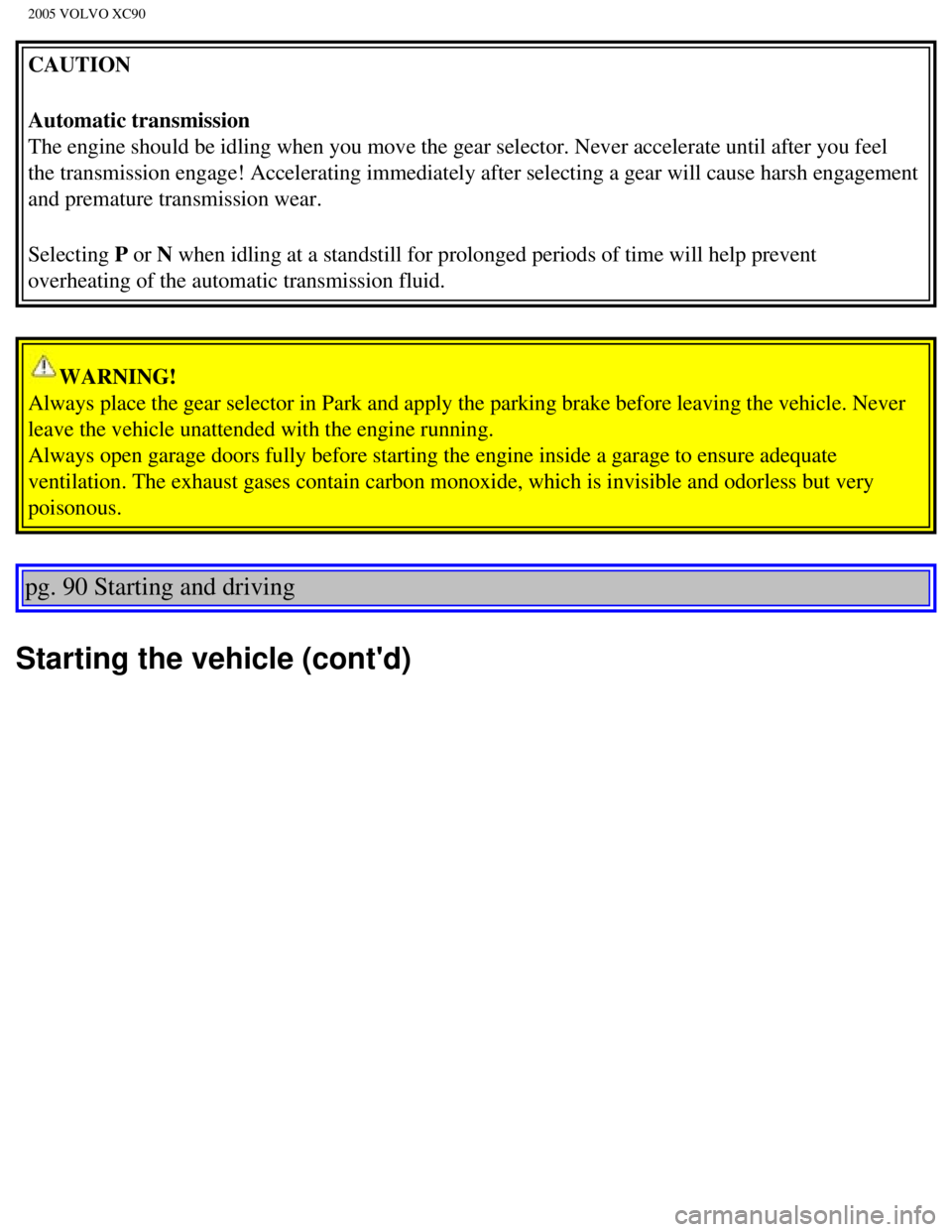2005 VOLVO XC90 automatic transmission
[x] Cancel search: automatic transmissionPage 2 of 263

2005 VOLVO XC90
instructions and maintenance requirements/recommendations in this manual\
. We also urge you and your
passengers to wear seat belts at all times in this (or any other) auto\
mobile. And, of course, please do not operate
a vehicle if you may be affected by alcohol, medication or any impairmen\
t that could hinder your ability to
drive.
Your Volvo is designed to meet all applicable safety and emission standa\
rds, as evidenced by the certification
labels attached to the driver's door opening and on the left wheel housi\
ng in the engine compartment.
For further information please contact your retailer, or:
In the USA:
Volvo Cars of North America
Customer Care Center
P.O. Box 914
Rockleigh, New Jersey 07647-0914
1-800-458-1552
http://www.volvocars.us
In Canada:
Volvo Cars of Canada Ltd.
National Customer Service
175 Gordon Baker Road
North York, Ontario M2H 2N7
1-800-663-8255
http://www.volvocanada.com
General information
Shiftlock (automatic transmission)
When your vehicle is parked, the gear selector is locked in the (P)ark position. To release the selector from this
position, turn the ignition key to position II (or start the engine), \
depress the brake pedal, press the button on the
front side of the gear selector and move the selector from (P)ark.
When you switch off the ignition, the gear selector must be in the (P)ark position before the key can be
removed from the ignition switch
Anti-lock Brake System (ABS)
The ABS system in your vehicle performs a self-diagnostic test when the \
vehicle first reaches the speed of
approximately 12 mph (20 km/h). The brake pedal will pulsate several t\
imes and a sound may be audible from
the ABS control module. This is normal.
Fuel filler door
The fuel filler door, located on the right rear fender, is connected to \
your vehicle's central locking system.
Press the button on the light switch panel (see illustration on
page 33) when the vehicle is at a standstill to
unlock the fuel filler door. Please note that the fuel filler door will \
remain unlocked until the vehicle begins to
move forward. An audible click will be heard when the fuel filler door r\
elocks.
file:///K|/ownersdocs/2005/2005_XC90/05xc90_00.htm (2 of 7)12/30/2006 \
4:42:22 PM
Page 20 of 263

2005 VOLVO XC90
vehicle. The SRS system is a supplement to the seat belts.
WARNING!
Never drive with the airbags deployed. The fact that they hang out can i\
mpair the steering of your
vehicle. Other safety systems can also be damaged. The smoke and dust fo\
rmed when the airbags are
deployed can cause skin and eye irritation in the event of prolonged exp\
osure.
pg. 10 Safety
Airbags (Supplemental Restraint System) (contd)
WARNING!
If your vehicle has been subjected to flood conditions (e.g. soaked car\
peting/standing water on the
floor of the vehicle) or if your vehicle has become flood-damaged in an\
y way, do not attempt to start
the vehicle or put the key in the ignition before disconnecting the batt\
ery (see below). This may cause
airbag deployment which could result in personal injury. Have the vehicle towed to an authorized
Volvo retailer for repairs.
Automatic transmission:
Before attempting to tow the vehicle, use the following procedure to ove\
rride the shiftlock system to
move the gear selector to the neutral position.
l Switch off the ignition for at least 10 minutes and disconnect the batte\
ry
l Wait at least one minute
l Insert the key in the ignition and turn it to position II
l Press firmly on the brake pedal.
l Move the gear selector from (P)ark to the (N)eutral position.
There is no maintenance to perform on the SRS yourself. The month and ye\
ar shown on the decal on the
door pillar indicate when you should contact your Volvo retailer for spe\
cific servicing or replacement of
airbags and seat belt pretensioners. This maintenance must be performed \
by an authorized Volvo retailer.
Should you have any questions about the SRS system, please contact your \
authorized Volvo retailer or
Volvo Customer Support: In the U.S.A In Canada:
Volvo Cars of North America Volvo Cars of Canada Ltd.
Customer Care Center National Customer Service
file:///K|/ownersdocs/2005/2005_XC90/05xc90_01a.htm (13 of 15)12/30/20\
06 4:42:24 PM
Page 41 of 263

2005 VOLVO XC90
continuously with the needle in the red area of the dial, which indicate\
s maximum allowable engine rpm
range. Instead, shift to a higher gear or slow the vehicle down. The eng\
ine management system will
automatically prevent excessively high engines speeds. This will be noti\
ceable as a pronounced
unevenness in engine speed.
10. Gear and driving mode indicator
The currently selected driving mode is displayed here. If you use the op\
tional Geartronic function on the
automatic transmission, the currently selected gear will be displayed.
11. Ambient temperature gauge
This display indicates the air temperature outside your vehicle. A "snow\
flake" symbol in the text
window is displayed when the temperature is in the range of 23 - 36° \
F (-5 - +2° C). Please note that this
symbol does not indicate a fault with your vehicle. At low speeds or whe\
n the vehicle is not moving, the
temperature readings may be slightly higher than the actual ambient temp\
erature.
12. Clock/set button
Turn the button to set the clock.
13. Fuel gauge
The fuel tank holds approximately:
Models with 6-cylinder turbo engines - 19 US gallons (72 liters).
Models with 5-cylinder turbo engines - 18 US gallons (68 liters).
When a warning light in the gauge comes on, there are approximately 1.8 \
US gal. (8 liters) of fuel
remaining in the tank.
14. Indicator and warning symbols
pg. 27 Instruments and controls
Indicator and warning symbols
The indicator and warning symbols light up when you turn the ignition ke\
y to the driving position
(position II) before starting. This shows that the symbols are functio\
ning. When the engine starts, all
symbols go out. If the engine is not started within 5 seconds, all symbo\
ls except CHECK ENGINE and
go out. The symbol for the parking brake goes out when the parking brak\
e is released.
Warning symbol
in center of instrument panel
This symbol shines as a red or yellow light depending on the severity of\
the fault that has been detected.
Red symbol -Stop the vehicle as soon as possible in a suitable location and read th\
e message shown in
file:///K|/ownersdocs/2005/2005_XC90/05xc90_02a.htm (3 of 17)12/30/200\
6 4:42:27 PM
Page 115 of 263

2005 VOLVO XC90
2 0 0 5
VOLVO XC90
Starting and driving
pg. 85 Starting and driving
Refueling86
Starting the vehicle89
General information91
Automatic transmission with Geartronic93
All Wheel Drive96
Brake system97
Dynamic Stability Traction Control (DSTC)99
Park assist101
Towing 102
Jump starting 104
Towing a trailer 105
Detachable trailer hitch - installing/
removing 107
Load carriers 108
Cold weather precautions 109
Before a long distance trip110
file:///K|/ownersdocs/2005/2005_XC90/05xc90_06a.htm (1 of 16)12/30/200\
6 4:42:33 PM
Page 120 of 263

2005 VOLVO XC90
3. Without touching the accelerator pedal, turn the ignition key* to the\
starting position. Allow the
starter to operate for up to 10 seconds. Release the key as soon as the \
engine starts. If the engine fails to
start, repeat this step.
NOTE:
- On certain models, when the vehicle is started, idle speed may be noti\
ceably higher than normal for a
short period, depending on the temperature of the engine.
This has been done to help bring components in the emission control syst\
em to their normal operating
temperature as quickly as possible, which enables them to function norma\
lly.
- For cold starts at altitudes above 6000 ft (1800 meters), depress th\
e accelerator pedal halfway and turn
the key to the starting position. Release the pedal slowly when the engi\
ne starts.
4. To release the gear selector from the (P)ark position, the engine must be running (or the ignition key
must be in position II) and the brake pedal must be depressed.
5. Select the desired gear. The gear engages after a very slight delay w\
hich is especially noticeable when
selecting R.
NOTE: Your vehicle is equipped with a Keylock system. When the engine is switc\
hed off, the gear
selector must be in the (P)ark position before the key can be removed from the ignition switch.
When starting in cold weather, the transmission may shift up at slightly\
higher engine speeds than
normal until the automatic transmission fluid reaches normal operating t\
emperature.
Do not race a cold engine immediately after starting. Oil flow may not r\
each some lubrication points fast
enough to prevent engine damage.
* If two of the keys to your vehicle are close together, e.g., on the sa\
me key ring, when you try to start
the vehicle, this could cause interference in the immobilizer system and\
result in the vehicle not starting.
If this should occur, remove one of the keys from the key ring before tr\
ying to start the vehicle again.
file:///K|/ownersdocs/2005/2005_XC90/05xc90_06a.htm (6 of 16)12/30/200\
6 4:42:33 PM
Page 121 of 263

2005 VOLVO XC90
CAUTION
Automatic transmission
The engine should be idling when you move the gear selector. Never accel\
erate until after you feel
the transmission engage! Accelerating immediately after selecting a gear\
will cause harsh engagement
and premature transmission wear.
Selecting P or N when idling at a standstill for prolonged periods of time will help pre\
vent
overheating of the automatic transmission fluid.
WARNING!
Always place the gear selector in Park and apply the parking brake befor\
e leaving the vehicle. Never
leave the vehicle unattended with the engine running.
Always open garage doors fully before starting the engine inside a garag\
e to ensure adequate
ventilation. The exhaust gases contain carbon monoxide, which is invisib\
le and odorless but very
poisonous.
pg. 90 Starting and driving
Starting the vehicle (cont'd)
file:///K|/ownersdocs/2005/2005_XC90/05xc90_06a.htm (7 of 16)12/30/200\
6 4:42:33 PM
Page 123 of 263

2005 VOLVO XC90
* The gear selector must be in the (P)ark position (automatic transmission).
** Please be aware that leaving the key in this position will increase b\
attery drain.
pg. 91 Starting and driving
General information
Economical driving conserves natural resources
Better driving economy may be obtained by thinking ahead, avoiding rapid\
starts and stops and
adjusting the speed of your vehicle to immediate traffic conditions. Obs\
erve the following rules:
l Bring the engine to normal operating temperature as soon as possible by \
driving with a light foot on
the accelerator pedal for the first few minutes of operation. A cold eng\
ine uses more fuel and is subject
to increased wear.
l Whenever possible, avoid using the vehicle for driving short distances. \
This does not allow the engine
to reach normal operating temperature.
l Drive carefully and avoid rapid acceleration and hard braking.
l Use the transmission's (D)rive position as often as possible and avoid using "kickdown" to help
improve fuel economy.
l Do not exceed posted speed limits.
l Avoid carrying unnecessary items (extra load) in the vehicle.
l Maintain correct tire pressure. Check tire pressure regularly (when tir\
es are cold).
l Remove snow tires when threat of snow or ice has ended.
l Note that roof racks, ski racks, etc, increase air resistance and also f\
uel consumption.
l At highway driving speeds, fuel consumption will be lower with the air c\
onditioning on and the
windows closed than with the air conditioning off and the windows open. \
l Using the onboard trip computer's fuel consumption modes can help you le\
arn how to drive more
economically.
Other factors that decrease gas mileage are:
l Dirty air cleaner
l Dirty engine oil and clogged oil filter
l Dragging brakes
l Incorrect front end alignment
Some of the above mentioned items and others are checked at the standard\
Maintenance intervals.
Weight distribution affects handling
At the specified curb weight your vehicle has a tendency to understeer, \
which means that the steering
wheel has to be turned more than might seem appropriate for the curvatur\
e of a bend. This ensures good
stability and reduces the risk of rear wheel skid. Remember that these p\
roperties can alter with the
vehicle load. The heavier the load in the cargo area, the less the tende\
ncy to understeer.
file:///K|/ownersdocs/2005/2005_XC90/05xc90_06a.htm (9 of 16)12/30/200\
6 4:42:33 PM
Page 125 of 263

2005 VOLVO XC90
NOTE: Avoid driving on steep inclines if the fuel tank is nearly empty. If the\
flow of fuel to the engine
is interrupted due to the vehicle's angle of inclination, this could res\
ult in damage to the three-way
catalytic converter. We recommend keeping the fuel tank at least half fu\
ll when driving on steep inclines.
Driving through water
l The vehicle should not be driven through water that is deeper than 18 in\
ches (48 cm). Driving through
deeper water could result in damage to transmission components or the di\
fferential, or to the engine if
excess water is drawn in through the air intake system.
l Drive slowly and avoid stopping when driving through water.
l After having driven through water, apply the brakes lightly several time\
s to remove water, mud, etc
from the brake discs.
l Never allow the vehicle to stand in water above the door sills. This cou\
ld result in damage to the
electrical system.
Conserving electrical current
Keep the following in mind to help minimize battery drain:
l When the engine is not running, avoid turning the ignition key to positi\
on II (see page 90). Many
electrical systems (the audio system, the optional infotainment/navigat\
ion systems, power windows, etc)
will function with the ignition key in position I. This position reduces\
drain on the battery.
l Please keep in mind that using systems, accessories, etc that consume a \
great deal of current when the
engine is not running could result in the battery being completely drain\
ed.
NOTE: A warning message will be displayed in the text window in the instrument\
panel when the
battery charge is low.
pg. 93 Starting and driving
Automatic transmission with Geartronic
5-cylinder turbo models
file:///K|/ownersdocs/2005/2005_XC90/05xc90_06a.htm (11 of 16)12/30/20\
06 4:42:33 PM